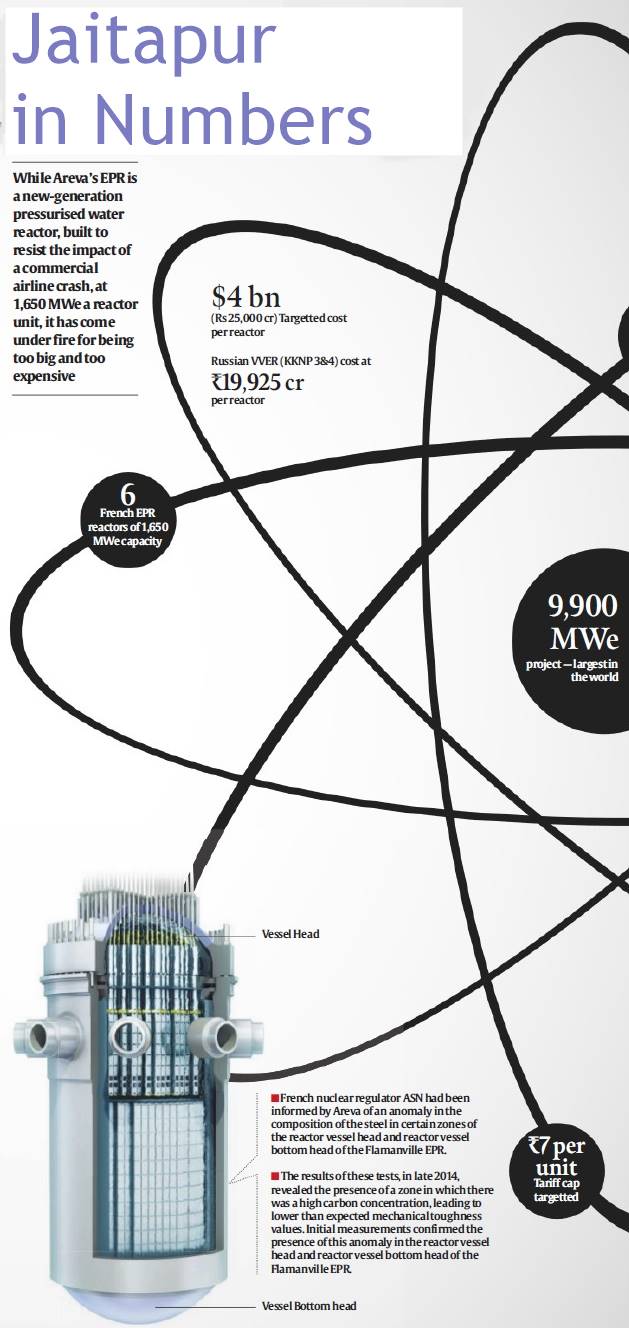- India
- International
Jaitapur Nuclear Plant: Next stop, safety assessment
Amid red-flags in France, Areva’s pact with NPCIL to kick off licencing process of world’s largest nuclear plant.
 While Areva’s EPR is a new-generation pressurised water reactor, built to resist the impact of a commercial airline crash, at 1,650 MWe a reactor unit, it has come under fire for being too big and too expensive.
While Areva’s EPR is a new-generation pressurised water reactor, built to resist the impact of a commercial airline crash, at 1,650 MWe a reactor unit, it has come under fire for being too big and too expensive.
For the proposed Jaitapur nuclear power project, touted as the largest nuclear power generating station in the world by net electrical power rating, a crucial Pre-Engineering Agreement signed between state-owned Nuclear Power Corp (NPCIL) and French reactor vendor Areva last month will set the ball rolling on the detailed safety assessment for the proposed 9,900 MWe (mega watt electrical) project. It would also set the stage for commencing the licensing process for the French EPR reactor-based project with India’s nuclear regulator — the Atomic Energy Regulatory Board.
This comes in the backdrop of Areva facing regulatory fire over weak spots in the steel of its EPR (formerly called European Pressurised Reactor) reactor it is building for French state-owned utility EDF at the Flamanville site in France, according to findings released by French nuclear regulator ASN earlier last month. ASN had said Areva had informed it that tests at 2014-end had shown that in certain zones of the reactor vessel and the cover of the EPR, there was a significant concentration of carbon, which weakened the mechanical resilience of the steel and its ability to resist the spreading of cracks.

While Areva’s EPR is a new-generation pressurised water reactor, built to resist the impact of a commercial airline crash, at 1,650 MWe a reactor unit, it has come under fire for being too big and too expensive. Areva has been forced to book billions of euros in provisions due to cost overruns at the three sites globally where it is setting up EPR-based projects.
For the proposed project at Jaitapur project, after the signing of General Framework Agreement (GFA) and Early Works Agreements (EWA) in 2010, detailed discussions were held with Areva on various technical, safety and commercial aspects of the projects to arrive at a viable project proposal. In parallel, pre project activities like land acquisition, rehabilitation and resettlement (R&R), technology independent site investigations, infrastructure development at site, and public awareness activities are being carried out at the site.
“The Pre-Engineering agreement or PEA signed between NPCIL and Areva on April 10 will help bring clarity on the technical aspects of the plant, help make a detailed safety assessment and take up the licensing process with Atomic Energy Regulatory Board, an official involved in the exercise said. An MoU (memorandum of understanding) was also signed between L&T and Areva aimed at maximising the localisation of critical components for the proposed 10,000-MW nuclear power plant at Jaitapur, which marks a desperate attempt to prune the cost of each of the six 1,650 MWe reactors to be deployed at the site in Maharashtra to about $4 billion. This is expected to translate into a generation cost equivalent of about Rs 7 per unit.

The meeting of this price cap imposed by the government during the ongoing technical negotiations, officials said, holds the key to the viability of the Jaitapur project, especially in light of Areva’s chequered track record at implementing EPR reactor-based projects elsewhere in the world.
Areva’s EPRs are being deployed at two sites in Europe — in Olkiluoto, Finland, apart from the site Flamanville in France and two reactor units in Taishan,China. The construction of the Finnish reactor being built at Olkiluoto since 2005 has repeatedly suffered from serious delays and cost overruns. The reactor was planned for commissioning by 2009 and five years on, it’s still far from ready. Its cost has doubled and there are doubts on whether it will be ready even by the revised deadline of 2018.
The targeted cost of $4 billion (approx Rs 25,000 crore) per reactor is roughly the same as the Areva offer to the Chinese for the two EPR reactors under construction at Taishan in China, which is believed to incorporate an engineering joint venture, unlike the Indian project proposal. The Flamanville EPR reactor in France is also having problems. Construction was started in 2007 and was supposed to generate power by 2012. That, too, is delayed and is now scheduled to start in 2016.
The L&T deal signed earlier last month is expected to get orders for making heavy and critical components such as pressure vessels and steam generators and these orders will be executed by L&T Special Steel and Heavy Forgings, a joint venture between L&T and the Nuclear Power Corporation of India. This venture has a manufacturing facility in Hazira, Surat.
“Localisation is the only way to bring down cost, especially as the NPCIL has been driving a hard bargain on tariffs being capped at Rs 7 per unit (kWh),” a company official said. In India, the cost benchmark for new imported light water reactors such as the EPR are derived broadly from the two Russian designed VVER-1000 reactors which are to be deployed at the Kudankulam site. The two new VVER reactor units (KKNPP 3 & 4) to be set up in Tamil Nadu, which would come up at the Kudankulam site where two identical units (KKNPP 1 & 2) are nearing commissioning, entail a sanctioned project cost of Rs 39,849 crore for the two new reactors.
Apr 26: Latest News
- 01
- 02
- 03
- 04
- 05








































